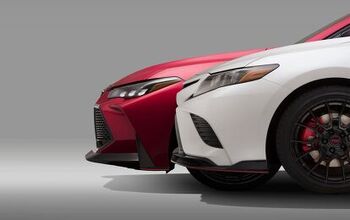A Question of Lust: Toyota Unwraps the Camry and Avalon TRD

You’ve seen teasers all week, suffered through breathless commentary from NASCAR drivers, but it’s finally time. The big day has arrived. On Friday, Toyota pulled the remaining wraps off its Camry TRD and Avalon TRD, highlighting the features of its tricked-out sedans ahead of their official debut at the LA Auto Show.
Jokes aside, the TRD treatment applied to this pair is more than just an appearance upgrade, even if buyers aren’t the recipient of additional ponies. Positioned as an aspirational model for those who want more from their sensible, front-drive sedan, the TRD duo is designed to hold the road and stop faster. They’re also made to draw eyes to two models that, despite their heritage, remain just as vulnerable to changing consumer tastes as other sedans.
But are these really “the track-tuned sedans that enthusiasts have been asking for,” as Toyota claims?
I’d hazard a guess that the appearance of Toyota’s racing arm in the mainstream passenger car field is more likely to sway an already committed Camry or Avalon intender into upgrading, rather than bringing in outside buyers. An upsell via the eyes and ears, if you will.
The changes bestowed upon the new-for-2018 Camry and new-for-2019 Avalon in TRD spec are many. They include upgraded brakes with 12.9-inch front rotors and red, dual-piston binders (apparently borrowed, sans paint, from the Sienna minivan, as per Bozi Tatarevic), with 12-inch/single-piston binders in the rear.
Power in both sedans comes by way of an untouched 3.5-liter V6 generating the same 301 horsepower and 267 lb-ft of torque you’ll find in stock, non-hybrid Avalons and higher-end Camrys. Sport mode and paddle shifters come as part of the package, not that the latter feature stands to see much use. The only transmission is, apparently, a similarly unmolested eight-speed automatic — a unit your author finds fault with for laggy downshifts.
Once those ponies start charging, you’ll at least hear them. Unlike the questionable, audio-enhanced engine growl (I never noticed much of one) in the Avalon XSE, these rides benefit from a cat-back exhaust for a more menacing aural experience.
Improved roadholding comes by way of half-inch wider, 19×8.5-inch wheels shod with Bridgestone Potenza 235/40R19 summer rubber, with new, stiffer springs bringing a 0.6-inch reduction in ride height. Those springs pair with beefier front and rear sway bars, TRD shocks, and enhanced underbody bracing for decreased roll and bolstered body stiffness. Just how stiff these legs are off the track remains to be seen.
Of course, no bystander’s likely to notice those chassis upgrades on the street, but the aero enhancements detailed already on these pages will get their attention. The body kit applied to both models includes a front splitter, side aero skirts, trunk lid spoiler (mercifully low-profile on the Avalon), and rear diffuser. Red-line TRD strips underscore the add-ons both inside and out. And just look at those red seatbelts. Certainly, no passenger will be able to miss the TRD badge stitched or stamped onto various interior surfaces, and there’s even a trunk mat to remind them of the car’s unique nature.
Paint choices total four: Supersonic Red, Windchill Pearl, Celestial Silver Metallic, and Midnight Black Metallic, with the first three shades coming in a two-tone layout on the Camry.
While Toyota doesn’t list a price for these two beasts, expect the TRD treatment to run at least an additional three grand on top of the XSE trim. Availability comes in the fall of 2019, when both vehicles land as 2020 models.
[Images: Toyota]

More by Steph Willems
Latest Car Reviews
Read moreLatest Product Reviews
Read moreRecent Comments
- Kwik_Shift_Pro4X What's worse than a Malibu?
- MaintenanceCosts The current Malibu is poorly packaged; there's far more room inside a Camry or Accord, even though the exterior footprint is similar. It doesn't have any standout attributes to balance out the poor packaging. I won't miss it. But it is regrettable that none of our US-based carmakers will be selling an ordinary sedan in their home market.
- Jkross22 You can tell these companies are phoning these big sedans in. Tech isn't luxury. Hard to figure out isn't luxury.This looks terrible, there are a lot of screens, there's a lot to get used to and it's not that powerful. BMW gave up on this car along time ago. The nesting doll approach used to work when all of their cars were phenomenal. It doesn't work when there's nothing to aspire to with this brand, which is where they are today. Just had seen an A8 - prior generation before the current. What a sharp looking car. I didn't like how they drove, but they were beautifully designed. The current LS is a dog. The new A8 is ok, but the interior is a disaster, the Mercedes is peak gaudy and arguably Genesis gets closest to what these all should be, although it's no looker either.
- Ajla My only experience with this final version of the Malibu was a lady in her 70s literally crying to me about having one as a loaner while her Equinox got its engine replaced under warranty. The problem was that she could not comfortably get in and out of it.
- CoastieLenn Back around 2009-2010, a friend of mine had a manual xB and we installed a Blitz supercharger kit. Was a really fun little unit after that.






































Comments
Join the conversation
No Android auto, no sale for me.
The red Avalon is a perfect example of how ugly a front end can be. If I had one I would lose a lot of weight because I would puke every time I went out to the garage and saw it. I can't think of an uglier car from recent times. Given the hate I have for oblesks in the middle of the dash, I would still buy a Stinger over this if that were the only choice.